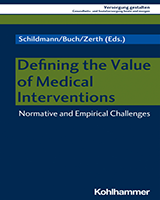Before we describe how SOC can be included in an HTA report and present an example of how we have integrated the domain into an HTA on the integrative mistletoe therapy in breast cancer patients, we explain why these aspects should be included.
2.1 The purpose of integrating patients and social aspects
Our HTA report is a practical example of how patient experiences influence the value of a technology.1 In this chapter, we will not go into more detail about whether and why the patients and social perspective should be included, but we refer to the clear statement of the HTAi interest group for patient and citizen involvement, which sees great potential in the integration of the SOC domain. The interest group for patient and citizen involvement at HTAi states its position clearly on their website: “Vision: Patient and citizen perspectives improve HTA” (HTAi, 2020a).
In general, SOC should be integrated into HTA to understand the perspective of people affected by the health technology. The domain and the term “people affected” usually refers to patients (if necessary, represented by their parents or other relatives), individuals and caregivers (IQWIG, 2017b). Caregivers come from the private environment of the patient, as family or friends, and are not healthcare professionals paid for the service (EUnetHTA, 2016b). The SOC domain provides information on what motivates patients to claim a treatment or intervention, respectively, what motivates individuals to use preventive interventions. Experiences regarding the impact of a health technology on everyday life and the perceived value of the quality and the benefit of the health technology can only be provided by those people affected (EUnetHTA, 2016b). Information on issues which promote or prevent a demand can also identify underlying unmet needs of the patients. Unmet needs can be diverse and may relate to information or social needs, uncertainty on the effectiveness and safety of a treatment, or limited access. The unmet needs are sometimes easy to meet, for example, if a patient wants to have the opportunity to discuss treatment options with a trusted doctor.
The SOC domain does not only include information on the motivation for using a certain health technology but also on how information is communicated to patients or where patients’ needs, such as the need for information, are not met within the healthcare system (EUnetHTA, 2016b). Good counselling on a health technology, for example, improves the health literacy of the patient so that they can be a responsible decision maker regarding their own treatment process.
In addition to informing the patient about individual risks regarding the treatment, each therapy planning needs a benefit-risk assessment on an individual level before suggesting a therapy to the patient (Ernst and Klein, 2017). In case unmet needs arise that are related to patient information, communication, access to a treatment or other topics, the SOC domain would be the appropriate place to provide information on these aspects if available and suggest how to react adequately.
Since decisions on the implementation and refunding of health technologies are increasingly complex and have to be made under scarce resources, some countries (e.g. Australia) try to expand public engagement in order to create more transparency (Wortley et al., 2017).
A mapping review at EU level summarises the HTA processes of HTA agencies in Europe and describes similarities and differences in the approach leading to the creation of an HTA product (Chamova, 2017).
The German HTA agency Institute for Quality and Efficiency in Healthcare (IQWIG) involves patients in the dossier assessment (IQWIG, 2017a), in the suggestion (called “IQWIG ThemenCheck Medizin”) and selection of topics for HTA, and offers the public the chance to react in written form on study plans and preliminary HTA reports (IQWIG, 2017b).
However, what is usually missing in HTA across different HTA agencies is the inclusion of the patients’ perspective in the HTA report in the form of a literature review, as is done in other domains. To summarise the relevant evidence on SOC helps to represent the patients’ perspective better.
Lehoux and Williams-Jones (2007) see an important responsibility of HTA agencies is to also constitute the diversity of social and ethical issues in addition to evidence on clinical and economic questions. Already addressing aspects as social justice and transparency in the HTA report helps decision makers to bring together public expectations, (moral) values, and evidence on effectiveness, safety and cost-effectiveness (Lehoux and Williams-Jones, 2007). A summary of existing evidence on the elusive topic of SOC makes it easier for decision makers to make sure they do not accidentally ignore important aspects.
2.2 Relevant outcomes for the patients and social aspects domain
The SOC domain in the HTA Core Model® contains eight assessment elements (see ), which constitute the relevant outcomes for the domain. These assessment elements are assigned to three different thematic groups: patients’ perspectives (which also include caregivers), social groups’ aspects and communication aspects.
Assessment elements for the patients and social aspects domain according to the EUnetHTA HTA Core Model® (EUnetHTA, 2016b, p. 348).
Some aspects may be irrelevant for the intervention under assessment, but each aspect should be checked for relevance. If it is not possible to answer all research questions, it is important to state which questions could not be answered based on the existing literature (EUnetHTA, 2016a).

